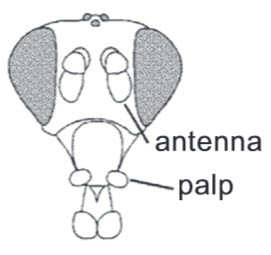Creating e-noses using fruit flies
October 15, 2014

Schematic of olfactory sensory functions in a fly’s head (credit: Thomas Nowotny et al./Bioinspiration and Biomimetics)
The “nose” (sensors on the antennas) of the common fruit fly (drosophila melanogaster) could soon be used to detect illegal drugs and explosives, based on new research that has revealed the fly’s impressive ability to detect a wide range of smells, as described in an open-access paper published today (October 15) in the journal Bioinspiration and Biomimetics.
The researchers, from the University of Sussex, Monash University, and CSIRO Australia, hope to integrate the fly sensors into future electronic noses (e-noses), making the devices much faster and more sensitive to a host of chemicals.
The e-noses could be used in applications such as law enforcement, health monitoring, food-quality testing, environmental management, and even geological monitoring (volcanoes) and agriculture (detecting pests).
“In looking at fruit flies we have found that, contrary to our expectation, unfamiliar odors such as those from explosives were not only recognized, but broadly recognized with the same accuracy as odors more relevant to a fly’s behavior,” said lead author Professor Thomas Nowotny from the University of Sussex,
In the study, the researchers recorded how 20 different fruit-fly receptor neurons, collectively known as olfactory receptor neurons, responded to 36 chemicals related to wine (representing the fermenting fruit that forms part of the fruit fly diet) and 35 chemicals related to hazardous materials.
The researchers then measured the activity, or spikes, from the neurons to see which chemicals elicited the strongest response from the fruit fly. The best recognition accuracy was achieved when all 20 of the receptors were used; however, 90 per cent of the performance could be achieved with just 10 or 11 receptors.
“It would be quite difficult to recreate the entire nose,” said Nowotny. “Even adopting all receptors would be too difficult. In this paper we show that it could work with as little as 10 fruit fly receptors and we identify the most likely candidates to use.”
Commercially available e-noses currently have between two and 18 sensors (mostly metal oxide sensors) embedded into them, whereas most insects have between 50 and 300 biological sensors, which can operate on timescales of milliseconds — up to 1000 times faster than metal oxide sensors.
Abstract of Drosophila olfactory receptors as classifiers for volatiles from disparate real world applications
Olfactory receptors evolved to provide animals with ecologically and behaviourally relevant information. The resulting extreme sensitivity and discrimination has proven useful to humans, who have therefore co-opted some animals’ sense of smell. One aim of machine olfaction research is to replace the use of animal noses and one avenue of such research aims to incorporate olfactory receptors into artificial noses. Here, we investigate how well the olfactory receptors of the fruit fly, Drosophila melanogaster, perform in classifying volatile odourants that they would not normally encounter. We collected a large number of in vivo recordings from individual Drosophila olfactory receptor neurons in response to an ecologically relevant set of 36 chemicals related to wine (‘wine set’) and an ecologically irrelevant set of 35 chemicals related to chemical hazards (‘industrial set’), each chemical at a single concentration. Resampled response sets were used to classify the chemicals against all others within each set, using a standard linear support vector machine classifier and a wrapper approach. Drosophila receptors appear highly capable of distinguishing chemicals that they have not evolved to process. In contrast to previous work with metal oxide sensors, Drosophila receptors achieved the best recognition accuracy if the outputs of all 20 receptor types were used.
